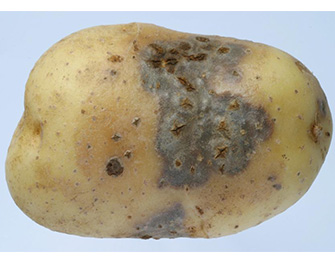Symptoms
The ‘ABC’ name refers to (A) dark brown raised patches, (B) dark sunken lesions, sometimes in rings or horseshoe shapes, and (C) light brown cracked patches. Any combination of these symptoms may occur but look for dark coalescing rings, very dark patches, and mild light tan patches. All are often associated with distinctive small corky lesions that crack through the skin and superficially resemble elephant hide (see Rhizoctonia). The blemishing can be very severe.
Transmission
TNV is transmitted by a soil fungus Olpidium brassicae via zoospores. Resting spores can survive for many years. TNV causes disease in tulip, bean and cucumber and infects a wide host range without symptoms.
Control
Little is known about the disease but long rotations would be a sensible precaution for infected fields. Elimination of alternative host plants will help reduce the risk of disease. Take care to prevent potentially contaminated soil from infecting clean fields.
